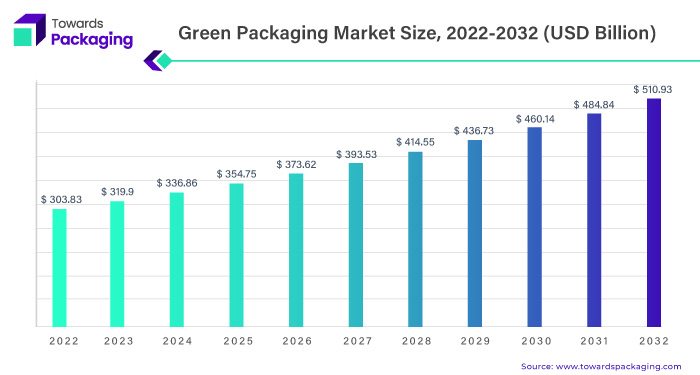Table of Contents
ToggleGreen Packaging Market Growth and Outlook
The global green packaging market is projected to expand from USD 303.83 billion in 2022 to approximately USD 510.93 billion by 2032, growing at a compound annual growth rate (CAGR) of 5.3% from 2023 to 2032.

Download Statistical Data: https://www.towardspackaging.com/download-statistics/5067
The Rise of Green Packaging: A Sustainable Solution for a Healthier Planet
Concerns over the harmful impact of single-use plastics on the environment, combined with growing consumer awareness of sustainable packaging benefits, are driving the global green packaging market’s rapid expansion. Plastic packaging has been widely used across various industries, contributing significantly to plastic waste and marine pollution. As people become more aware of the negative effects of plastic, along with governments implementing policies to reduce plastic use, the demand for eco-friendly packaging solutions is expected to rise.
The adoption of sustainable packaging is accelerating in industries like healthcare, food and beverages, and personal care. The food and beverage sector, for example, is increasingly using recycled and biodegradable materials in packaging. A clear trend is emerging where traditional plastic packaging—such as single-use plastics, caps, lids, straws, and trays—is being replaced by compostable alternatives in food service. This shift supports both sustainability and hygiene goals. These changes are expected to significantly boost the green packaging market in the coming years.
Eco-Friendly Materials in Green Packaging
Green packaging solutions rely on biodegradable and recyclable materials, offering various options:
- Bioplastics (plant-based plastics)
- Post-consumer products (such as recycled bulk bags)
- Recycled paper and plastics
Here are some examples of eco-friendly packaging currently in use:
- Starch-Based Biomaterials: Cornstarch-based packaging has grown in popularity. Derived from corn, this material is much more environmentally friendly than traditional plastics. It’s used in applications like soda bottles and loose-fill packaging material. Many U.S. national parks, including Yellowstone, use cornstarch-based biodegradable containers in their hotels and cabins, highlighting its growing use in the hospitality industry.
- Plant-Based Biomaterials: Polylactic acid (PLA), a biodegradable plastic made from agricultural waste like corn or sugarcane, is a popular alternative to conventional plastics. Companies like Coca-Cola and Pepsi are leading the way with sustainable packaging. Coca-Cola’s PlantBottle, for example, is made from sugarcane-based materials, and Pepsi has created a fully plant-based bottle using switchgrass, corn husks, and pine bark. These materials are recyclable and biodegrade faster than petroleum-based plastics.
- Biodegradable Packaging Peanuts: As cities like New York ban foam-based products, businesses are switching to biodegradable packing peanuts made from starch and wheat. These peanuts dissolve harmlessly in water, reducing environmental harm. This shift reflects the growing demand for sustainable packaging alternatives.
- Corrugated Bubble Wrap: Traditional bubble wrap is non-biodegradable, but many companies are adopting corrugated cardboard as a more eco-friendly alternative. This material offers the same cushioning effect but is much easier to recycle, showing a commitment to greener packaging.
- Mycelium (Mushroom-Based Materials): Mushroom-based packaging is a unique and sustainable option. Companies like IKEA are already using mycelium to replace Styrofoam in their packaging. This material is biodegradable and offers a more sustainable alternative to traditional packaging methods.
- Recycled Cardboard and Paper: While not as flashy as new materials, recycled paper and cardboard are still highly effective and eco-friendly. When made from recycled content, these materials are biodegradable and have a lower environmental impact compared to virgin materials.
- Post-Consumer Recycled Plastics: While not biodegradable, post-consumer recycled plastics play an essential role in sustainability. By reusing plastics instead of producing new ones, they help reduce energy consumption and carbon emissions. They are a practical alternative in situations where newer materials may not be feasible.
- Organic Fabrics: Organic materials like hemp, flax, and recycled cotton offer an alternative to plastic bags and containers. These fabrics biodegrade much faster than plastic, reducing the environmental burden. They are a promising solution for replacing single-use plastic items.
- Restored and Renewed Products: Some companies, like Bulk Bag Reclamation, focus on recycling and renewing products like bulk bags. This reduces waste by extending the life of materials and contributes to a circular economy.
Buy Premium Global Insight: https://www.towardspackaging.com/price/5067
Get the latest insights on packaging industry segmentation with our Annual Membership – https://www.towardspackaging.com/get-an-annual-membership
If you have any questions, please feel free to contact us at sales@towardspackaging.com
Browse our Brand-New Journal:
https://www.towardshealthcare.com
https://www.towardsautomotive.com
For Latest Update Follow Us: https://www.linkedin.com/company/towards-packaging/
Get Our Freshly Printed Chronicle: https://www.packagingwebwire.com/